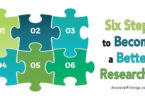Sometimes, the direct proof we need just isn't there in genealogy. Records are missing or non-existent. The records we do find have inaccuracies or missing information in them. We find records that have conflicting information. It can be frustrating when we can't directly prove the relationships we need to prove for our research. However, just because we can't make a direct connection between two people (or between a person and an event) doesn't mean that we can't make a reasonable assumption about it.
These reasonable assumptions are called “reasonable conclusions” in genealogy, and, provided you make them in the correct manner, they are acceptable for use in articles in scholarly and recreational genealogical journals and books. The Board of Certification of Genealogists even accepts well done reasonable conclusions as a legitimate means of conducting genealogy research. In fact, part of their certification course for professional genealogists involves doing a piece of research that relies solely on making a reasonable conclusion from the available evidence.
What is a Reasonable Conclusion?
A reasonable conclusion is one that is made based on analyzing a variety of data and record sources and using these to come to the most likely scenario based on the evidence provided. You won't be using just one source when you make a reasonable conclusion. You will be using multiple sources of information. You have to. If you use just one piece of information, it will only tell you what is on that record, and the information may be inconclusive. You need more than that to come to a reasonable conclusion.
Examining and comparing different sources of information will give you a bigger picture of what is going on with your ancestors. You may find some conflicting information. You may never find anything that directly points to one person as being connected to the other. The important thing is to compare the evidence and decide where it seems to be leading you. You also have to consider the reliability of the various pieces of information you are examining. Only once you put everything together and decide how accurate it is and what it seems to be telling you can you come up with a reasonable conclusion that professional genealogists would accept.
How Do You Put Together Different Information Sources to Reach a Reasonable Conclusion?
First, you must consider the reliability of the information you're examining. Is it a primary source, a secondary source, an original or derivative document, and does it provide direct or indirect evidence of the event or relationship you are looking to prove? While primary and original sources that provide direct evidence are usually considered the most reliable sources, this is not always the case.
Take into consideration who provided the information. Was it a minister who married a couple, on a record made at the time of their marriage? Or was it written down in the family Bible years after the fact, maybe by a child or grandchild of the married couple you are studying? If it was written down by someone who wasn't there, it can be subject to error. Human memory is fallible, and even if the grandparents told the grandchildren when and where they were married, that information may have been forgotten or corrupted in their memory by the time they get around to writing it down in the family Bible or some other family record.
The same thing goes for death certificates. While the date of death is pretty reliable, because it was recorded by the attending doctor or other person present at the time a person died, other information on the certificate may not be as reliable. For example, the descendent's birth date and place, and the names of their parents may not be correct, as this information is provided by someone who was likely not present at their birth (unless the descendent was a child) and may or may not have known the descendent's parents.
Take a look at the name of the informant on the death certificate and try to determine their relationship to the descendent. Are they related closely, distantly, or not at all? Does the information they provided conflict with other information you have? If so, look at the origins of your other information. Does your additional information have more reliable sources? If so, you may want to put more weight on those sources regarding the birth date and the names of the parents than the information provided on the death certificate. Comparing information like this and examining its origin and reliability is key to establishing a reasonable conclusion in genealogy.
Genealogy is Never 100 Percent Certain, But We Can Make it as Certain as We Possibly Can
Genealogy is not an exact science. By its very nature, it never can be 100 percent certain on anything, except in a very few rare cases of DNA analysis of close relatives. However, using our reasoning skills, analytical skills, and a wide variety of sources to compare, we can come up with the most reasonable conclusions possible in our research, and be strongly certain that we are correct. Always examine many different record sources in your own genealogical research, and you will have a sound family history to give to future generations.




